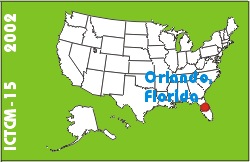
Electronic Proceedings of the Fifteenth Annual International Conference on Technology in Collegiate MathematicsOrlando, Florida, October 31-November 3, 2002Paper C019Fractals for the Classroom on Calculators and Computers |
Brian R. O'CallaghanSoutheastern Louisiana University 500 Western Avenue SLU 10582 Hammond, LA 70402 USA Phone: (504) 549-5894 bocallaghan@selu.edu list of all papers by this author |
| Click to access this paper: |
ABSTRACT
Fractals are contemporary geometric notions within Chaos theory that are accessible to students at almost any level and can be used to generate interest and enthusiasm among students of all ages. One of the most familiar fractals is the Sierpinski Triangle. I will describe how this triangle can be generated, and I will demonstrate this on the TI-83 Plus SE. The resulting figure consists of an infinitely repeating, self-similar pattern of three smaller triangles forming the larger one. The 'compression ratio' (the size of the smaller triangles as compared to the larger one) for this Sierpinski Triangle is one half.Similar processes can be used with six points and a compression ratio of one third to generate a Sierpinski Hexagon or five points and a compression ratio of three eights to generate a Sierpinski Pentagon. Other interesting images can be formed by using various rotations of the points about the vertices. Examples of these types of fractals will also be demonstrated with the calculator.
Finally I will reference a website designed by Robert Devaney as part of the Dynamical Systems and Technology project at Boston University. This site can produce fractals in color with a great deal of speed and flexibility.
Keyword(s): chaos and fractals, graphing calculators
